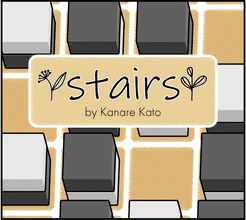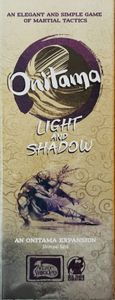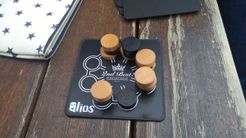|
Advertisement
|
Jericho

DescriptionJericho, a strategy game for 2 playersOVERVIEWNumber of players: two. Average duration of a game: thirty minutes. Game Board: one octagonal board consisting of two by thirteen (2 x 13) squares and two by thirteen (2 x 13) triangular squares at the edge of the board. HOW TO PLAYAt the commencement of the game, the board is empty and each player stores his/her 25 allocated pieces on the side. The starting player places one piece on either his/her territory, (the 13 squares in front of him/her) or on his/her opponent's territory (the 13 squares in front of the opponent). Both players then take turns placing pieces on the board. Once on the board, the pieces remain in the some place throughout the whole game. Towers are consisting of single pieces or several pieces piled on top of each other. THE TOWERSThe Towers are built with a minimum of one and a maximum of 4 pieces. Each piece in an individual Tower must have different sizes and colours. The Towers belong to the player whose territory they are built on. A player can for example choose to place a Tower on his/her opponent's territory to undermine the strength of the opponent's Towers: this Tower belongs to the opponent. THE CONFRONTATIONSTowers confront each other when they are aligned, whether diagonally or frontally. There can be 7 frontal alignments and 6 diagonal ones. When one player has got 2 of his/her Towers on a same alignment, only the strongest one can enter a confrontation. HOW STRONG ARE THE TOWERS?The strength of a Tower depends on the size of its highest piece. The pieces can have 5 different sizes, hence the strength of a Tower can vary from I to 5. Whatever its number of pieces, only the highest will account for the strength of a Tower. For example, a two-piece Tower can win over a four-piece Tower. There is however one exception to this rule: one-piece Towers will always lose to higher Towers. When the highest pieces of two confronting Towers are of equal strength, then the piece that comes immediately under it is assessed and so on until the confrontation is resolved. THE MONOLITHS ("TRUMPETS")Monoliths are used to visualize which of the 2 players (at any stage in the game) has got the upper hand. Each time a player wins a confrontation, he/she is given a Monolith to position on his/her side of the board, on the triangle corresponding to the alignment where the confrontation just took place. The monolith remains with the player as long as he/she is a leader. However, if the opponent gets the upper hand then he /she is given the Monolith to place on his/her side of the board. When there is no obvious leader, the monolith is removed altogether from the board. HOW TO WIN?The player who wins his/her seventh monolith and does not lose it over to his/her opponent in the immediate next turn, wins the game. THE ASYMMETRY RULEA player cannot copy the move of his/her opponent by positioning immediately after him/her an identical piece (same size and colour) on the same alignment and at a same level of an identical Tower. At least one of these parameters must differ. Game DiscussionsAdd CommentYou need to be logged in to comment. Insert Bullet List Please enter at least one item. Item: Item: Item: Item: Item: Insert Numeric List Please enter at least one item. Item: Item: Item: Item: Item: Insert Link Please enter the link of the website Optionally you can add display text Insert Email Please enter the email address Optionally add any display text Insert Image Please enter the link of the image Insert YouTube Video Please enter the link of the video MarketplaceNo listings at the moment. Do you own this game? Click here to list it for sale.
|
Best Sellers
Board Games
|
||||
Latest Searches: mall of horror | 25+words+for+less | Woolly wars | Hammond oploy | Encounter at Hanover | dump | Mega civ | acdc | Escondido | Travel size Risk | indy | Bejelewed | Pokemon master trainer | death guard | wildwood opoly | ps4) ORDER BY 1 | Moto gp | youtube monopoly | Trivial pursuit afrikaans | Labirynth | tell a tale | Textile meechant | Simi valley opoly | four souls | Zathura | letters from white castle | Roxboro-opology | savage | Ants in the Pants | espn all sports trivia
All Rights Reserved











Comments (0)